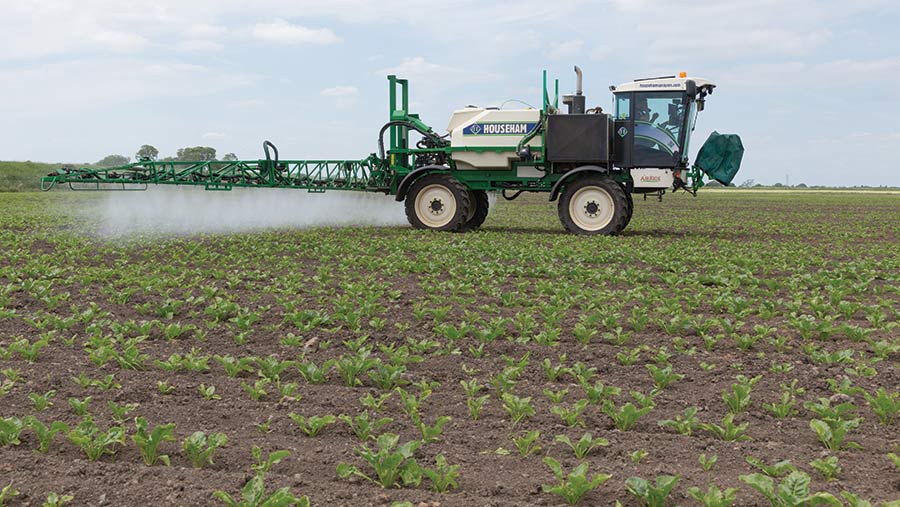Tips on tackling weeds in sugar beet without desmedipham
 © Tim Scrivener
© Tim Scrivener Sugar beet growers can still achieve effective control of costly weeds in crops without the herbicide desmedipham, although care should be taken as there is a higher risk of crop damage due to the greater reliance on mixing straights.
Post-emergence herbicide desmedipham has been the cornerstone of beet weed programmes for many years, offering control of key broad-leaved weeds such as cleavers, knotgrass and fat hen, especially in cooler and drier weather.
However, this spring is the last season that sugar beet growers can use products containing desmedipham, which cannot be used after 1 July.
See also: Beet growers set to benefit from herbicide-tolerant varieties
Effectively it means the loss of valuable formulations such as Bayer’s Bentanal range, like the four-way mix Betanal maxxPro (desmedipham + phenmedipham + ethofumesate + lenacil) and UPL’s Betasana Trio (esmedipham + phenmedipham + ethofumesate).
It’s also the last season for pre-emergence herbicide chloridazon, but it has a later final use date of 30 July.
As sales of desmedipham-containing products were not possible after 1 January, some growers may find themselves short of product and this spring will have to take a different approach to that of the past few years.
Looking at the alternatives, Darryl Shailes, research and development manager at agronomy group Hutchinsons, says there are fortunately plenty of approved options still available, “but we will have to be more precise with advice and applications”.
These include ethofumesate, lenacil, metamitron, phenmedipham, triflusufluron-methyl, clopyralid, quinmerac and dimethenamid-p.
Crop damage risk
Pam Chambers, national influencer at agrochemical firm UPL, adds that growers will, therefore, become more reliant on straights, which can bring greater risk of crop damage.
That means particular care should be given to temperature and crop conditions when spraying.
“There were some issues with herbicides in 2018 where the beet crop was generally drilled a month late, but then growth was very rapid and temperatures were very warm at spraying,” she says.
Ensuring crops are stress free when applying herbicides is, therefore, vital. Growers should avoid spraying during extreme temperatures such as frosts or hot conditions.
Optimising crop nutrient status and checking soil pH is also important, otherwise this can lead to plant stress and consequently herbicide damage.
Greater monitoring between sprays
To achieve good control, Mr Shailes says growers and agronomists need good knowledge of the remaining approved actives and to increase their crop monitoring between sprays.
“Growers are likely to be using more frequent applications of less effective products, with reduced spray intervals, so it’s essential they or their agronomist get into the field more frequently to monitor their crops.”
The identification of weed species, soil type and weather conditions will also be essential when choosing what active to apply and when.
“It will be important to mix and match products to fit the specific weed spectrum as the product used will highly depend on the type of weed, soil conditions and weather,” he adds.
For example, the residual metamitron is useful for tackling knotgrass and fat hen to build up residual and control cotyledon weeds.
Looking at conditions, he highlights that phenmedipham works better in warmer, more humid conditions, so where desmedipham is in short supply this season, it’s best to save it for cooler, drier conditions up to the last usage date and use phenmedipham when warmer and more humid, says Mr Shailes.
Mrs Chambers believes adjuvants can also play an important role in helping weed control and also increasing the efficacy of herbicide formulations.
However, careful consideration on the use of these products should be taken as they can also increase leaf damage if applied in the wrong conditions.
Cultural control methods
Cultural control methods provide another alternative to weed control in sugar beet crops, as the crop’s wide-row spacing creates ample room for a mechanical hoe to pass.
Improved technologies, such as GPS systems and camera guidance, further enable the potential success of this weed control method.
“Cultural methods should always be used where practical, and some growers may use a combination of mechanical weeding with conventional chemistry to enhance effectiveness,” says Mrs Chambers.

